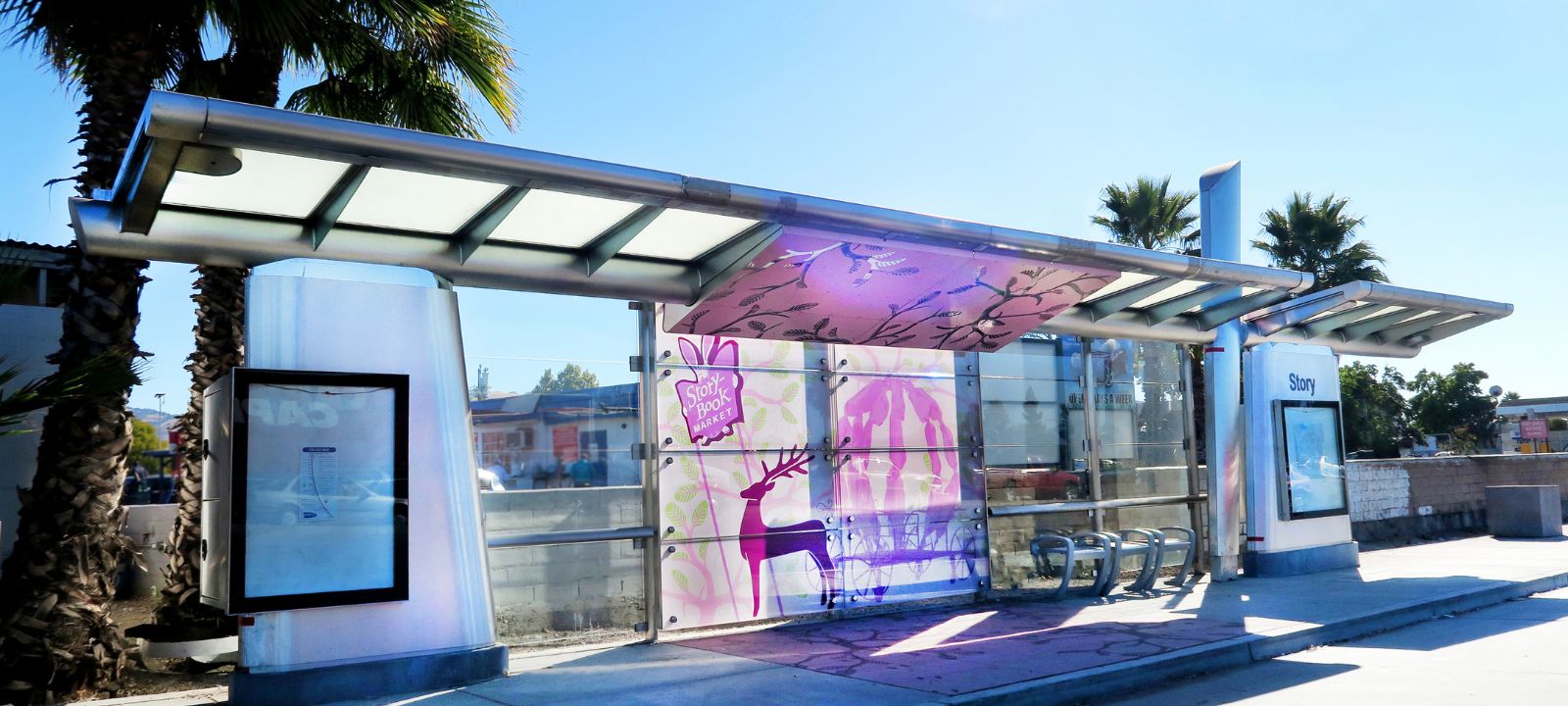These bus stations are making a colourful splash in California. In Santa Clara County, 21 new stations on the rapid bus line have beautiful colours that reflect the diversity of the neighbourhoods they traverse, while also creating a coherent identity along the 11.5km [7.2 mile] line.
The Santa Clara Transit Authority not only created faster travel times to downtown San Jose, it created a stunning visual journey too.
The colourful glass is courtesy of the talented artist collective – merge conceptual design. They created unique glass artwork as a backdrop to each station (on the station’s windscreen). The patterns at each station came from the stories and elements of the surrounding neighbourhood. Each station hub (both north and south bound platforms) were defined by a specific colour to further strengthen each station’s geographic location on the line.
Stella Solution – Part One – Uni-Clipz – Edge-Supported System
IBI Group – the design team – approached Stella for advice to support the glass windscreens. They wanted edge support for the glass but didn’t see any on the market that met their very specific performance requirements on this transit line. After collaborating with the designers and proposing various options, Stella created the Uni-Clipz system for this project.
While this system has proven to be popular in projects following Santa Clara, it was originally conceived and custom-made to meet this project’s specific needs.
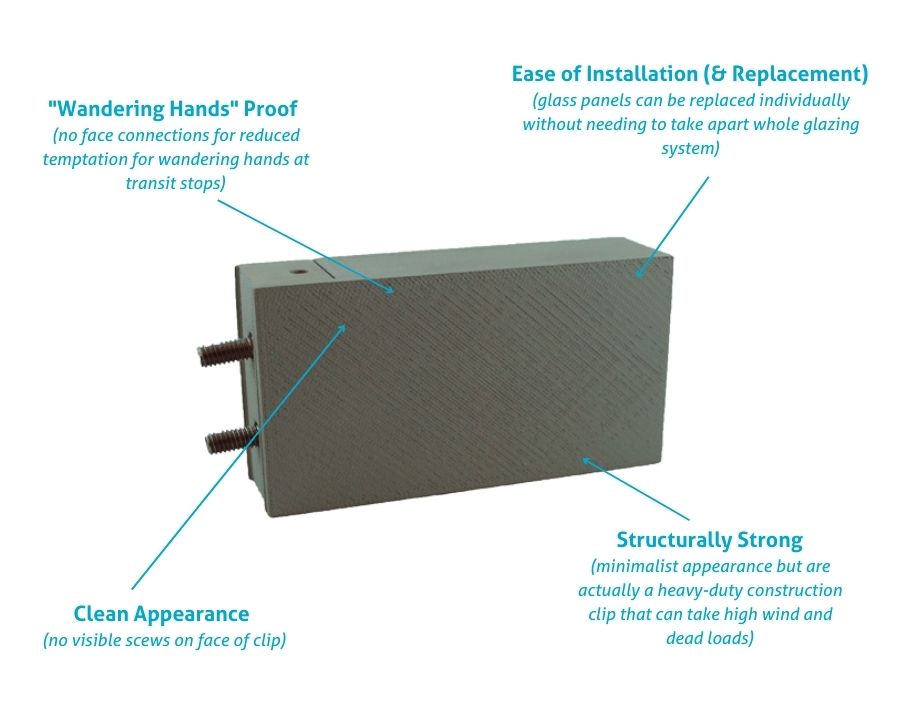
The challenges that the Uni-Clipz system solved for this project:
- Clean appearance – A key distinguishing feature of the Clipz is that there are no visible screws on the face of the clip.
- Structurally strong – Clipz have a sleek, minimal appearance (to keep the focus on the gorgeous glass art vs. its supporting structure), and are also a heavy-duty construction clip that can take heavy wind and dead loads. There is zero chance of glass slippage with Uni-Clipz’ strong connection (more than a common friction fit); there is also a ledge that the glass sits on.
- Ease of installation/glass replacement – Glass panels can be replaced individually without taking apart the whole system, saving time and money should alterations be needed in the future.
- Reduced glass fabrication costs – Uni-Clipz takes up to 16mm [5/8”] thick glass with no notches or holes needed in glass.
- Tamper Resistant – This was a major consideration; Uni-Clipz have no visible face connections meaning reduced temptation for wandering hands waiting at transit stops.
- Flexible design to fit a variety of applications along the 21 stations – Uni-Clipz were created as a complete family to accommodate multiple applications (left, right, intermediate connections) and can be rotated for further flexibility.
- See more photos of Uni-Clipz here
Stella Solution – Part Two – Custom Spider System for Fastest Install
But Stella didn’t stop there. Transparent glass was also needed for the stations and oval support columns were already designed for structural support. There wasn’t an off-the-shelf solution available, and with the large number of stations, it made economic sense to create a custom solution that would offer cost savings on the install hours.
It is a Stella philosophy that one less hole to drill on-site in steel across 1,000 fittings in a transit system can create huge cost savings. We keep this in mind when looking at the design of all our parts.
Stella re-imagined their existing side-mounted spider and created a custom cast spider that achieved the following project benefits:
- Direct attachment to the oval columns – Stella spiders were custom-cast to include a slight curve in their base to attach directly to the oval without an adaptor. This modification created significant labour savings as the adaptor would have been an additional part for installers to mount and install.
- Accommodation of key distance from centre of the spider to the inside face of glass – Unique design meant there was an extended distance of 83mm [3 ¼”] needed from the centre of the spider mount to the inside face of the glass. Stella’s custom glass bolts achieved this distance plus created additional labour savings as the new design eliminated the extra stand-off that would need to be coordinated, mounted, and installed.
- No through-bolt needed for spider installation – The fastening method to connect support to the oval column was a potential issue. Stella avoided the need to drill and tap into the thin-walled HSS via their use of a Stella nutsert. The nutsert is a Stella Innovation; a labour/cost-saving alternative to drilling and tapping and works well for thin-walled HSS. Stella nutsert functions like a rivet-nut and forms a collar on the inside of the HSS.
There is often a fear that custom hardware can have a higher sticker price. In this project, and many others, the custom hardware actually reduced overall project costs via reduction in install time and glass fabrication.
More about the art:
Each of merge’s designs were patterns inspired by stories and elements related to the surrounding neighbourhood of each station; merge did detailed research and community consultations to select the historic and contemporary themes.
The stories about the Artwork are paraphrased directly from the artist – merge conceptual design.
For more information about artwork – see here.
Alum Rock Station Artwork
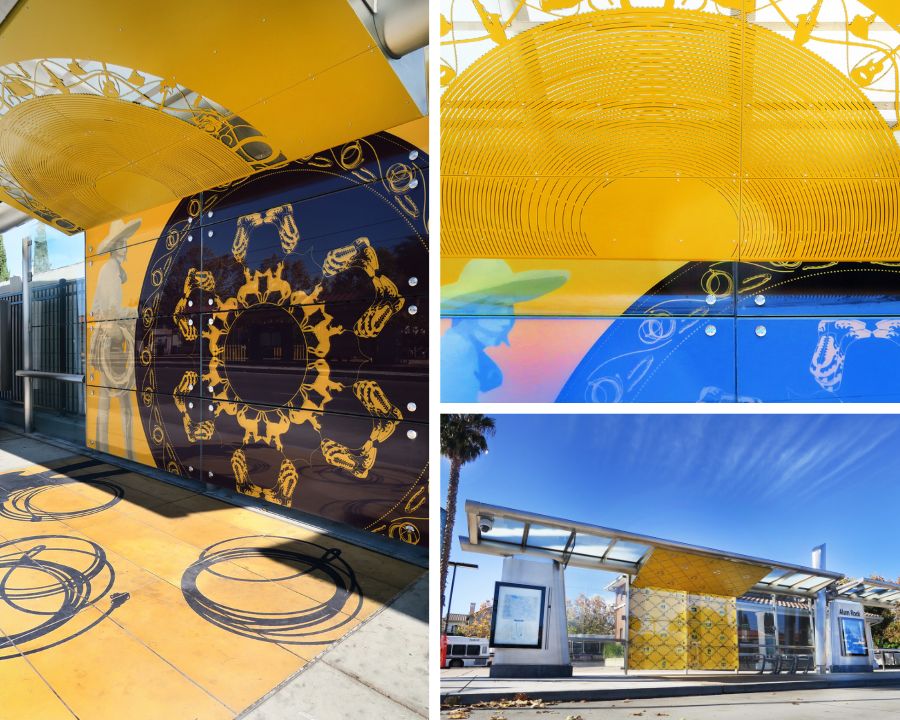
Images of Alum Rock Station (Image copyright – merge conceptual design)
Alum Rock Park, also dubbed “Little Yosemite”, is located in the foothills of San Jose at the end of Alum Rock Avenue. Founded in 1872, it is California’s oldest municipal park. The Alum Rock Railroad once ran from downtown San Jose along Alum Rock Avenue and ultimately to Alum Rock Park. A portion of today’s BRT line follows the alignment of the original railroad.
The patterns at this shelter are inspired by vintage postcards of the Alum Rock Park, the Alum Rock Railroad, and of the thenardite crystals found at the park – the crystals were originally mistaken for alum and gave the park the name. All elements are arranged in a pattern similar to a Victorian era wallpaper, referencing the time of the park’s heyday. A topographic map of Alum Rock Park provided the inspiration for the paving pattern.
Arena Station Artwork
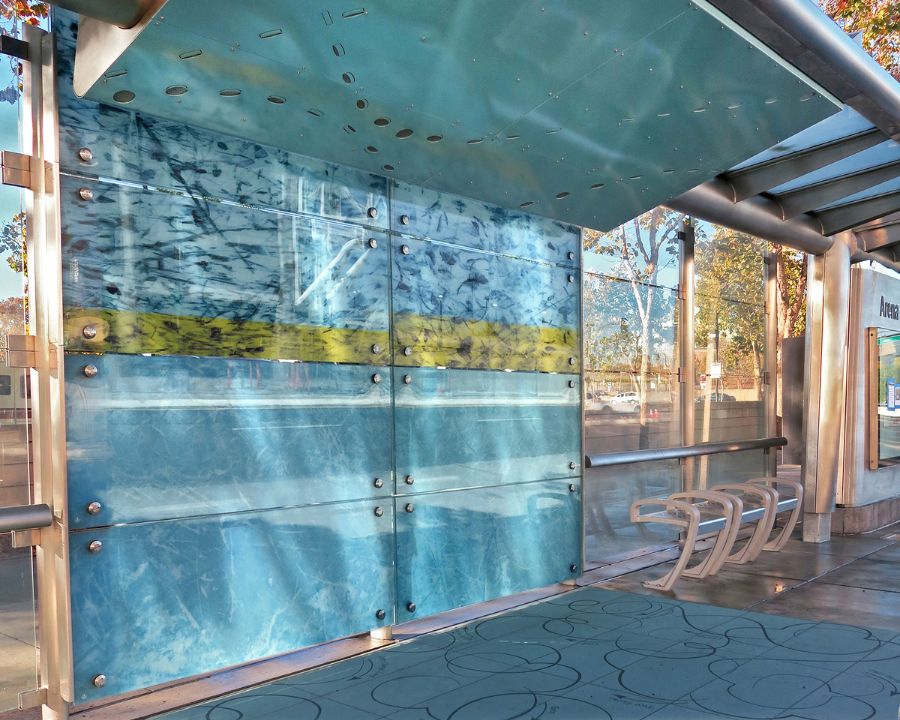
Arena Station – Can you see the puck images and skate paths? (Image copyright – merge conceptual design)
Arena derived its story from the ice arena located at close proximity to the shelter. Motifs were created from a flying puck, marks left at the hockey rink after a San Jose Sharks game (traces on ice, puck marks on bounds), and traditional figure skating instructions.
King Steet Station Artwork
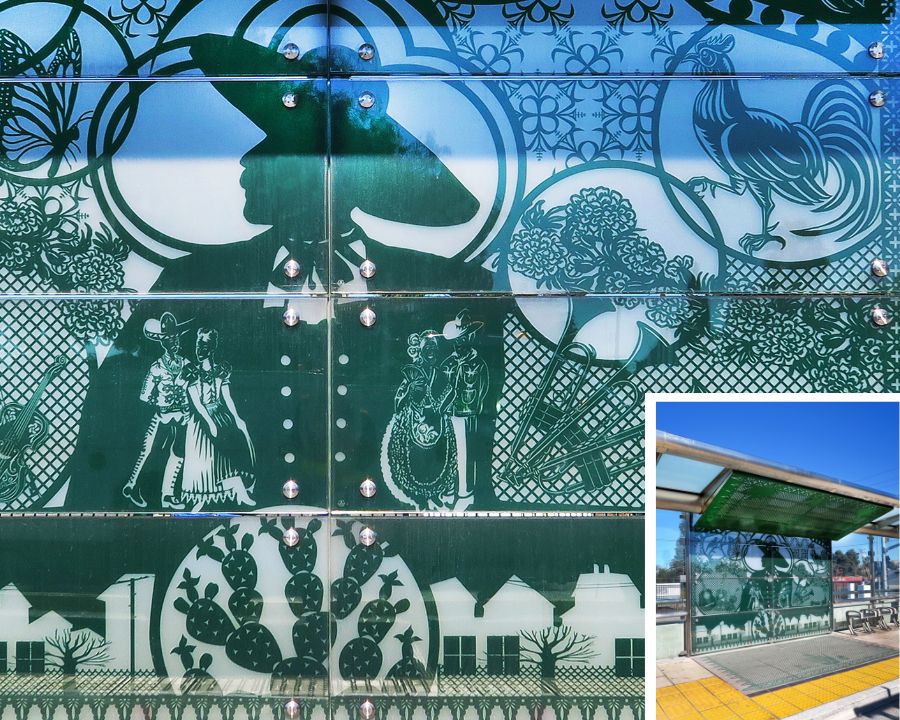
The inticate patterns of Papel Picado designed in collaboration with local artist Rick Moreno (Image copyright – merge conceptual design).
Both King Street station shelters are located in front of the Mexican Heritage Plaza, and its school of arts and culture. This important neighborhood institution is instrumental in keeping Mexican and Native American heritage, art forms, and traditions alive. The traditional Mexican folk art of Papel Picado was chosen to create the patterns at these two shelters. Papel Picado is a paper cut usually made from tissue paper that is commonly displayed for both secular and religious occasions. Papel Picado patterns were designed in collaboration with local artist Rick Moreno.
Project Team
- Project Name – Santa Clara/Alum Rock BRT (Bus Rapid Transit)
- Location – Santa Clara Valley, California
- Architect(s) – IBI Group (Seattle) / merge design
- Glazing Contractor – Tolar Manufacturing
- Client – Santa Clara Valley Transportation Authority

